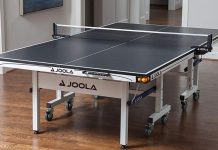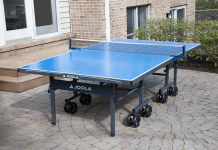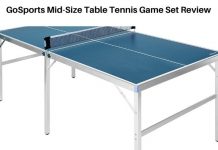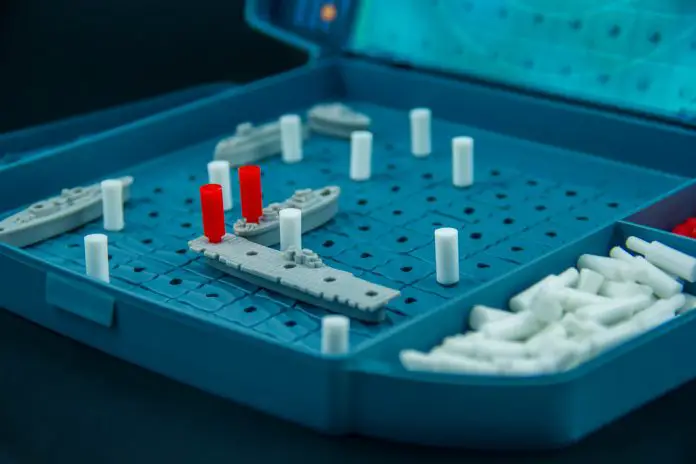Ask any family to list which board games they own. I guarantee you that you won’t find a single family that doesn’t own Battleship. In fact, according to this article, it’s one of the highest-selling board games of all time. There’s a lot of good reasons for that. It’s simple to learn, usually pretty quick to play, and is just good old-fashioned fun. I’m sure you know how to play, but do you have a tried-and-true Battleship strategy for consistent victories?
You probably don’t usually think about needing a strategy to win at this game. Most people (at least the ones I talked to – my 10 year-old son, his best friend, and my neighbor kid who knocked on my door to get his ball out of my backyard) think you just place your ships, shoot at your opponent, and cross your fingers hoping that you don’t get hit. Nothing could be further from the truth. If you want to have a better-than-fifty-percent chance of winning, you need a strong Battleship strategy in place when you sit down to the game.
Table of Contents
Why Battleship is Amazing
I write about board games, so it goes without saying that I’m a huge board game fan. When each of my kids was close to getting out of diapers I was already dreaming about sitting down to some of my favorite board games to play with each of them. But I learned quickly that neither one was going to be a chess prodigy, unfortunately. My older one won’t even be a checkers prodigy. Neither of them was quite ready for a game of Catan at age 4. But Battleship was a game that each could understand very easily.
I began playing against them without using any of my usual strategy that I’ll lay out below. I just placed my ships randomly, picked a square to shoot at completely at random, and hoped for the best. They did the same because they were little kids and didn’t know any other way to do it. And what happened? They’d beat me about half the time. This shouldn’t be surprising. Not having a strategy in most games is a clear way to not win nearly as much as you want to.
But when I decided to go in to killer mode and use my Battleship strategy against my kids? They literally haven’t beaten me since then. Not once. Am I proud of using advanced strategies to trounce my elementary-school-aged kids at a board game?
Absolutely. Nothing excites a suburban parent like smoking their child at board games.
Of course I hope that you’ll take these strategies and beat people who have at least a double-digit age. I want you to beat whatever kids you may have around too. Keep reading to find out how I destroy everyone I play, kids and adults alike.
Tips for Building Your Battleship Strategy
The great thing about building a Battleship strategy is that each phase of the game is separate. This helps make sure that you don’t have to pick-and-choose which strategies to prioritize. If you’ve read my Catan strategy guide you’ve probably seen that you sometimes have to make decisions about which strategy to follow if the game doesn’t play out in the way you think it will. With Battleship you don’t have to make those types of decisions. Each phase of the game is completely separate. Your opponent’s game play doesn’t affect yours at all once the game begins. Let’s get started.
The very first thing you’ll do after you open the box you’ll set up your flotilla – take out your 5 ships and figure out how you’re going to set them up. Everyone has a different idea about the best ways to do that, but here are the things I do to make sure my opponents can’t find me very quickly.
1. Don’t let your ships touch each other
Some players will say that your ships should touch because it may confuse your opponent about which ships they’ve already hit. But eventually your opponent is going to figure out what you’ve done. Since they may have already hit two ships thinking that it’s just one, they’ll know exactly where to go back and fire.
The other problem is that it’s human nature to keep firing in the same area. If they sink your carrier, their next few shots may be in other squares that touch your carrier. Since so many people set up their own ships this way they also think that everyone else sets their up that way. If you’ve got another ship there, your opponent has an easy target. As much as possible, make sure your ships have 1-2 squares of separation so your opponent can’t find your ships as quickly.
You can still try to pack your ships in a reasonably small area if you’d like, but actually letting them touch gives your opponent an easy way to find more ships quickly. Clearly, I’d advise against letting your opponent find your ships faster than they have to. Giving your ships a little room to breathe should make sure that your opponent doesn’t find your ships too quickly.
Here are 12 more strategies for placing your ships.
2. Don’t create patterns with your ships
Humans love patterns – it’s just how we’re wired. Patterns make it easier for us to make sense of the world around us. It feels natural to create a pattern with your ships, but your opponent will be thinking in patterns too. If you create a pattern out of your ships, your opponent is likely to pick up on that and figure out your pattern quickly.
What does this look like in practice? Some people place all of their ships vertically, or all starting on the top row. I’ve seen people create letters (an uppercase L or U are common) or common shapes. If your opponent realizes you’ve done this, they’ll know exactly where to fire next.
Ideally, if I was to look at your board after you’ve placed your ships, I shouldn’t be able to figure out why you placed your ships the way you did. If I can say “oh look, you made a (square, letter, rectangle, etc.)”, then you need to rethink your placement. Spread them out and make sure they don’t all face the same direction.
3. Avoid the middle as much as possible
People like to shoot at the middle. It’s a big open space and many people tend to assume you have to have placed a ship right near the middle of the board. Many people that I play start with a shot in one of the middle squares. If at all possible, try to avoid this. Since your opponent is likely to fire near the middle of your board at the beginning of the game, keeping your ships away from there should give you more time to hopefully find their ships first.
Mainly I’m talking about the middle 4 squares (E5, F5, E6, F6). Trying to avoid more of the middle than that is very hard while also still heeding the advice I have next. But consciously avoiding those 4 squares should slow down your opponent quite a bit and make your ships a little bit harder to find.
So am I telling you to push all of your ships to the edge, leaving a huge open sea in the middle of the board? No. Keep reading.
Related: A Strategy Guide for Trading in Monopoly
4. However, don’t pack all of your ships on the edge
This really goes along with what I said about not creating a pattern. You want to avoid the middle, but if all of your ships are right on the edge, your opponent will realize that and shoot all along the A and J columns and the 1 and 10 rows. I definitely put one ship along and edge, sometimes two ships if I’m feeling frisky. This avoids a pattern, and leaves a lot of open sea on the board between your other ships. But if you try to hide them all on the edge, you’re in for a loss.
If you read the two strategies above, it may seem like I’m telling you to avoid the entire board. Avoid the middle, don’t put everything on the edge? I get it. But there is a happy middle ground in these strategies. You can avoid the very middle of the board (E5, F5, E6, F6) without having to stick all of your ships right along the edge. That’s what I’m advising – avoid the very middle of the board without pushing your whole fleet to the edges.
5. Change up your placement between games
If you choose to follow all of these placement strategies, it would be very easy to find a placement that you like and use it every time. That way you don’t have to rethink your placement every time – just put your ships where you always do and get started.
Clearly, this would be bad.
It’s not likely that you have a large group of people that you play against. Battleship really tends to be more of a parents vs. kids or kids vs. kids game. Most adult board game nights don’t have Battleship on the regular rotation (although kudos to you if you do – way to change it up!). So you’ll probably be playing against the same people more often than not – your kids, your significant other, maybe a friend. If you always place your battleship on the top row and your aircraft carrier in the C column, your opponent will learn that and will shoot you down.
Follow the strategies I laid out above in tips 1-4, but mix it up. Pick a different ship to be the one you place on the edge, and pick a different edge to put a ship on. If you put your submarine near the top of the board in the last game, maybe put it towards one of the sides in the next game.
This doesn’t mean to just throw your ships out there randomly. Still use the strategies I laid out above. Just don’t be predictable, or else I’ll predict that you’ll lose more often than not.
Now your board is all set up and you’re ready to start blowing stuff up. Let’s move from the setup phase to the next phase of the game: attacking.
Related: Jenga Strategies to come out on top
6. Attacking at the beginning of the game
At the very beginning of the game, most people just start firing randomly until they hit something. But let’s think about this mathematically: there are 100 squares on the board, and the ships add up to 17 total squares (5 for the carrier, 4 for the battleship, 3 each for the submarine and the cruiser, and 2 for the destroyer). So it is mathematically possible to shoot 83 times without hitting a thing. That’s not likely, but it is possible and goes to show how difficult it is to hit something very early in the game. So how do we up our chances of hitting something?
Take a look at the board. With a little imagination, you can think of it like a chess/checkers board. Every other square a different color, right? Pick one “color” and only attack those. Why?
Look at the list of pieces above. Every ship is at least 2 squares long. That means every single ship has to have at least 1 spot on each “color” on the board. So you are guaranteed to hit every single ship this way, while cutting in half the number of squares you’re actively trying to attack.
This also makes sure that you find that pesky destroyer. Everyone who’s ever played Battleship knows the pain of having sunk the other 4 ships and then having to hunt down that tiny ship. If you only concentrate on attacking one “color” of squares on the board, you are guaranteed to find the destroyer.
7. Attacking after you’ve found a ship
There’s almost no bigger dopamine reward than seeing the sad look on your opponents face as they have to say “hit”. Placing a red peg on my attack board is SO. MUCH. FUN. But once you’ve got that first hit, what’s the best way to proceed from there?
My next step is to keep attacking the same “color” squares that I’ve been attacking the whole game, but around the square that you hit. So if I get a hit on D7, I’ll attack D5, D9, B7, and F7. First, this keeps your pattern so that you don’t end up missing a small ship. But this also helps tell you which ship you’ve found. Only the destroyer gets missed by this strategy, but of course then you’ll still know if you’ve found it. In the example above, if D5, D9, B7, and F7 are all misses, you know you’ve found the destroyer.
Let’s take a slightly different example. I’ve hit D7, just like above, and start my attack to find the rest of the ship. Let’s say that D9 is a hit too. Well now I know I’ve hit a bigger ship and can fill in from there.
This strategy helps you continue to cover a big portion of the board while you’re trying to find which direction the ship is facing. This will also help you counter your opponent using the common strategy of packing ships together. I’ve told you to avoid that, but many people still do it. Continuing to fire near the other ships in the same “checkerboard” pattern will help you find those ships that may be near by.
Related: Strategies to win Disney’s Villainous Board Game
8. Attacking after you’ve sunk a ship
With my strategies listed above, there really isn’t anything different you need to do in this case. After you’ve sunk a ship, keep going on your checkerboard pattern until you find the next ship and continue on.
But some people have a problem doing the checkerboard pattern I’ve advised to use. Maybe you’ve been playing for 30 years and can’t wrap your mind around shooting in a pattern. That’s okay. You can still win this way, but what you do after you’ve sunk one of your opponents ships can make the difference between winning and losing.
Many, many players pack their ships tight, or at least have ships touching each other – exactly what I’ve advised NOT to do. But there seems to be an idea that this is the best way to arrange your ships. The idea being that if ships are touching, it confuses the opponent as to what ship exactly has been sunk.
I don’t find that arrangement to be helpful in confusing my opponent. The reason is that you are required to tell your opponent when a ship has been sunk. More often than not, this makes it clear what you’ve actually hit. If you’ve already sunk your opponents aircraft carrier, and then have 5 hits in a row, that doesn’t confuse your opponent – it just tells them where two of your ships are instead of just one.
However, people still arrange their ships that way. So I always try to shoot around any ship I’ve just sunk. I cannot tell you how many times I’ve found another ship that my opponent tried to hide near another. Now I still shoot in my “checkerboard” pattern around the ship. But concentrating on those squares next to a just-sunk ship often reveals another one very quickly. Quickly finding ships puts tremendous pressure on your opponent.
Related: The Complete Clue Strategy Guide
9. Endgame
Once your opponent only has one or two ships left, it’s time for you to start thinking about the endgame. At this point it’s worthwhile to figure out which of your opponent’s ships are left and attack accordingly.
Recognizing which ships your opponent has left and attacking accordingly will help speed up your final attacks. You won’t have to be spending more shots in the checkerboard pattern than is truly necessary.
Example
Let’s say you’ve sunk everything except your opponent’s aircraft carrier. This is a big target – 5 squares long. At this point you don’t need to make sure you’re shooting at every other square in the checkerboard pattern I’ve discussed. You only need to make sure that you’re attacking any open space that’s 5 squares long. If you’re still doing the checkerboard pattern when your opponent only has big ships left, you’ll be wasting a lot of shots in small spaces when only big ships are there for the sinking.
Summarizing your new Battleship Strategy
Like I mentioned before, it is very helpful that there are two clear and distinct phases of this game – the setup, and the shooting. This makes it easier to keep your strategy in tact, as it’s difficult to lose your way in either phase of the game. It is also helpful that your opponent’s play doesn’t really affect your strategy in any way.
You may notice that I never mentioned anything about “paying attention to your opponent’s tendencies” or anything similar. That’s because most of your opponents will probably use the “random shot” method of firing at your ships. I rarely run across anyone who has a specific pattern that they shoot in, so paying attention to their tendencies won’t really help much. The people who do have any sort of pattern use my checkerboard method and there’s nothing you can do to avoid that, so you can really just play your own game without worrying about your opponent.
Your winning Battleship strategy starts at the setup when you lay out your flotilla. Place your ships randomly, no patterns. Using a pattern will make it easy for your opponent to follow your pattern and find your ships very quickly. Try to avoid the very middle of the board, and don’t place all of your ships on the edge (just one or two). If you can find a layout that follows all of these tips, you’re well on your way to a win. This layout will make it difficult to find all five of your ships, so you’ll have plenty of time to use my attacking strategies to find all of their ships first.
Fire at your opponent’s ships in a checkerboard pattern. That doesn’t mean you have to go from top-to-bottom or left-to-right, but just know which squares are part of your checkerboard. This cuts the number of squares you’re attacking in half and increases your chances of a hit. This also ensures that you’ll be able to find all 5 ships, since each ship will have to be part of the “color” of the checkerboard that you’re attacking.
Late in the game, with only one or two of your opponent’s ships remaining, you can often abandon the checkerboard if your opponent only has big ships left. Since you’re not looking for the smaller ships anymore, you don’t need to make sure that you’re hitting every other square. Adjust your shooting the match the size of the last ship.
Take these tips to heart the next time your kid decides to ask for a quick game of Battleship and you’ll be a winner in no time. Happy hunting!

Veronica is a Green Bay-based freelance writer and editor with extensive experience with board games. When not busy scribbling her thoughts, you might find her in her garden, hiking out in the woods, or exploring new food joints.
Veronica is a die-hard board game and chess hobbyist by night. She likes to try out new games and is always on the lookout to recruit new players for her game night (so beware!). When not playing board games or throwing darts, she is usually busy painting miniatures (or doing other nerdy stuff).
She is the CEO & Content Writer of Indoor Games Zone. She shares her expertise from years of playing chess, board games, and darts.

![Stiga XTR Pro Review | 1,559+ Global Ratings (In-Depth Guide) [year] Stiga XTR Pro Review](https://indoorgameszone.com/wp-content/uploads/2021/08/Stiga-XTR-Pro-Review-218x150.jpg)






